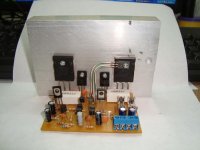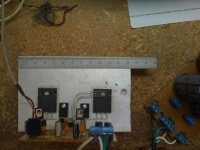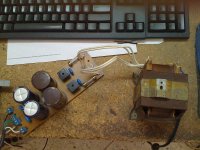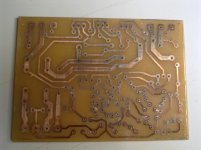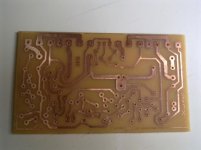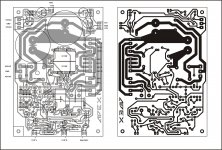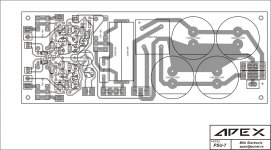apexaudio -
I don't think I will build one of these. I've already built a 100W amp, thanks.
Some things couuld be improved, I suggest. For example, probably, you could get lower distortion using conventional Darlingtons instead of Baxandall pairs. I would not use current sources sharing the same bias diodes, even with the resistor on the base (your input stage current source and VAS load).
John
I suggest don't change schematic, this will be new amp not AX14, useing high qulity parts is only improvements.
If you already built a 100W amp go to SR200 in thread: http://www.diyaudio.com/forums/solid-state/173462-studio-reference-amplifier-18.html
Regards
Last edited:
Ok Mr Mile, I TryI suggest ML3 for powered speaker preamp.
If you already built a 100W amp go to SR200 in thread: http://www.diyaudio.com/forums/solid-state/173462-studio-reference-amplifier-18.html
Regards
My speakers are an easy 9 ohm load and do fine with 50+ watts/channel.
I would like to build one of your amplifier designs and looked at this thread as well as your others on diyAudio.
My problem - you have several designs and I'm not sure which is the best sounding. I looked for a comparison of your various designs but could not find one. Is this "Ultimate fidelity" your best sounding amplifier in the 60-120 watt/ch range?
Thanks for sharing your expertise with techno-challenged people like me.
Francois
My speakers are an easy 9 ohm load and do fine with 50+ watts/channel.
I would like to build one of your amplifier designs and looked at this thread as well as your others on diyAudio.
My problem - you have several designs and I'm not sure which is the best sounding. I looked for a comparison of your various designs but could not find one. Is this "Ultimate fidelity" your best sounding amplifier in the 60-120 watt/ch range?
Thanks for sharing your expertise with techno-challenged people like me.
Francois
There is no 'best sounding amp' it's individual, if you want best and simple DIY amp build 'Ultimate Fidelity', but for best performance go to 'Studio Reference'.
Many people like 'Mosfet Amp' with IRFP and someone evan like sound of 'Quasi class B'.
Speakers is most important for 'good sound' in my expirience.
Regards
Hello
Thanks to Mile for sharing this amp, I built it last week, now I'm testing it, and wanted to share some images and comments.
I'm testing it with a 15 inch pa speaker, and with a 12 inch "home" speaker. I like better how it sounds on the 12 inch, I feel a little more bass, mid and high almost the same. The 12 inch uses piezo tweeters and the 15 inch uses 8 ohm, 1 inch driver.
Trafo is 41+41 Vac, from an old aiwa, rectified is +/-57Vdc, with 10000+6800uF per side, dc offset on output is 6 mv, normal heat while working, but i couldn't measure bias current on the 0.33 ohm resistor, don't know why, i just left the bias adjust on the middle...
I'm planning on using this as a "backup" amp, or for small parties. Next week I'll start the other channel. Price: less than 15 dollars on components. Heatsink, trafo and power supply were recycled from old projects.
When I finish the other channel and the case, I'll post some more images.
Greetings
Luigi
Thanks to Mile for sharing this amp, I built it last week, now I'm testing it, and wanted to share some images and comments.
I'm testing it with a 15 inch pa speaker, and with a 12 inch "home" speaker. I like better how it sounds on the 12 inch, I feel a little more bass, mid and high almost the same. The 12 inch uses piezo tweeters and the 15 inch uses 8 ohm, 1 inch driver.
Trafo is 41+41 Vac, from an old aiwa, rectified is +/-57Vdc, with 10000+6800uF per side, dc offset on output is 6 mv, normal heat while working, but i couldn't measure bias current on the 0.33 ohm resistor, don't know why, i just left the bias adjust on the middle...
I'm planning on using this as a "backup" amp, or for small parties. Next week I'll start the other channel. Price: less than 15 dollars on components. Heatsink, trafo and power supply were recycled from old projects.
When I finish the other channel and the case, I'll post some more images.
Greetings
Luigi
Attachments
Hello
Thanks to Mile for sharing this amp, I built it last week, now I'm testing it, and wanted to share some images and comments.
I'm testing it with a 15 inch pa speaker, and with a 12 inch "home" speaker. I like better how it sounds on the 12 inch, I feel a little more bass, mid and high almost the same. The 12 inch uses piezo tweeters and the 15 inch uses 8 ohm, 1 inch driver.
Trafo is 41+41 Vac, from an old aiwa, rectified is +/-57Vdc, with 10000+6800uF per side, dc offset on output is 6 mv, normal heat while working, but i couldn't measure bias current on the 0.33 ohm resistor, don't know why, i just left the bias adjust on the middle...
I'm planning on using this as a "backup" amp, or for small parties. Next week I'll start the other channel. Price: less than 15 dollars on components. Heatsink, trafo and power supply were recycled from old projects.
When I finish the other channel and the case, I'll post some more images.
Greetings
Luigi
Nice work, I suggest to put BD139 on pcb and connect to the heatsink directly.
Regards
My PCB Apex AX14
Thank you Mr Mile to share the PCB. I just finished printing pcb APEX AX14 and B80, I want to use standard components which are not FET Final to build this power. if I could get the layout of its components?
thanks in advance to Mr Mile. Greeting
http://www.diyaudio.com/forums/attachment.php?attachmentid=213002&stc=1&d=1299484536
http://www.diyaudio.com/forums/attachment.php?attachmentid=213003&stc=1&d=1299484536
Thank you Mr Mile to share the PCB. I just finished printing pcb APEX AX14 and B80, I want to use standard components which are not FET Final to build this power. if I could get the layout of its components?
thanks in advance to Mr Mile. Greeting
http://www.diyaudio.com/forums/attachment.php?attachmentid=213002&stc=1&d=1299484536
http://www.diyaudio.com/forums/attachment.php?attachmentid=213003&stc=1&d=1299484536
Attachments
Good ampPlease let me know where I can find PCB Files? I have 2sa and 2sc transistors, and this is a simple amplifierPlease how it sounds?
Post #708, and read the thread for more info.
Regards
Just incase it's helpful... my rather pessimistic order list (assuming that i mess up a few) for the discrete components, it's for 2 boards as i'm making a stereo system... sorry if someone else has posted
RESISTORS
220 * 20
560 * 12
10k * 6
47k * 10
1k * 8
4R7 * 8
0R33* 8
22k * 8
4 * 1K trimpot
8 * 5A fuses
CAPACITORS
22pf * 8
33pf * 4
100nf * 6
100pf * 4
1.5nf * 4
CAPACITORS - POLARISED
22uF 63V * 6
10uF 25V * 4
100uF 16v * 4
2.2uF 100V * 6
DIODES
1N4148 * 8
1N4007 * 6
RESISTORS
220 * 20
560 * 12
10k * 6
47k * 10
1k * 8
4R7 * 8
0R33* 8
22k * 8
4 * 1K trimpot
8 * 5A fuses
CAPACITORS
22pf * 8
33pf * 4
100nf * 6
100pf * 4
1.5nf * 4
CAPACITORS - POLARISED
22uF 63V * 6
10uF 25V * 4
100uF 16v * 4
2.2uF 100V * 6
DIODES
1N4148 * 8
1N4007 * 6
also, any advice on the current rating of the resistors?
Resistors 0,33 ohm must be 5W, all others are 0,25W.
Regards
Good day apex!
i have here a bunch of 2n3055, mj2955 trannies and 6ampres 28 0 28 traffo.
can i use these parts to build your 100 watts fidelity? sorry for my bad english.
Thanks in advance!

You can use 2N3055/MJ2955 for AX14, but only with regulated PSU (see posts #346 and #592). With 2X28V AC traffo there will be about +/-40V DC, You must set +/-30V output voltage (2N3055 is 60V device). Single PSU can be use for stereo amp.
Regards
Last edited:
Nice work, I suggest to put BD139 on pcb and connect to the heatsink directly.
Regards
Thanks Mile, it's the first time I've put this transistor that way, but I've seen some other designs where this transistor is over one of the final transistors to sense the temperature directly, and wanted to give this a try. What would be better, over a transistor or on the heatsink?
Luigi
Thanks Mile, it's the first time I've put this transistor that way, but I've seen some other designs where this transistor is over one of the final transistors to sense the temperature directly, and wanted to give this a try. What would be better, over a transistor or on the heatsink?
Luigi
It's wrong, temperature on plastic case is lower than heatsink temperature.
- Home
- Amplifiers
- Solid State
- 100W Ultimate Fidelity Amplifier
